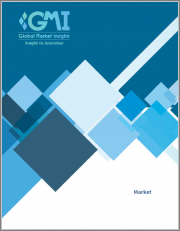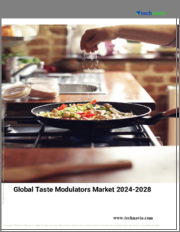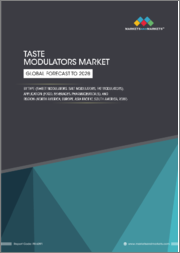
|
시장보고서
상품코드
1368647
테이스트 모듈레이터 시장 규모 : 유형별, 용도별, 예측(2023-2032년)Taste Modulator Market Size - By Type (Sweet Modulators, Salt Modulators, Sour Modulators, Bitter Modulators), By Application (Food and Beverage, Pharmaceutical, Nutraceutical) & Forecast, 2023 - 2032 |
||||||
세계의 테이스트 모듈레이터 시장은 2023-2032년에 CAGR 7.5% 이상을 보입니다.
세계에서 설탕, 소금, 지방 섭취를 줄이는 데 초점을 맞춘 건강한 식품 옵션에 대한 소비자의 선호도가 높아지면서 맛 조절제 시장의 성장을 가속하고 있습니다. 이러한 화합물은 식품 및 음료 제조업체가 영양 품질을 손상시키지 않고 풍미를 향상시킬 수 있습니다.
당뇨병 및 비만과 같은 건강 상태 증가로 인해 소비자들이 저칼로리 및 저당 제품을 찾게 되면서 사업 확장의 큰 기회를 창출하고 있습니다. 또한 식품 기술의 발전과 새로운 미각 조절 성분 시장 개척은 미각 프로파일을 개선하는 혁신적인 솔루션을 제공하여 시장 잠재력을 확대할 수 있습니다.
또한 클린 라벨 원료와 천연 맛 조절제에 대한 규제 당국의 지원은 소비자 선택과 제품 개발에 영향을 미쳐 시장 성장을 더욱 촉진하고 있습니다. 맛 조절제 제조업체와 식품 기업 간의 협업은 맞춤형 솔루션을 창출하고 혁신과 산업 확장을 촉진하는 데 도움이 될 수 있습니다.
시장은 유형, 용도, 지역별로 구분됩니다.
유형별로는 염도 조절제 부문이 분석 기간 중 상당한 CAGR을 기록할 것으로 보입니다. 건강을 중시하는 소비자의 나트륨 섭취량 감소 요구, 저염화를 촉진하는 정부의 구상, 더 건강하고 풍미있는 제품을 만드는 데 주력하는 식품 산업이 이 부문의 성장을 가속할 것입니다.
제약 용도는 2023-2032년 두드러진 CAGR을 보일 것으로 예상됩니다. 특히 소아과와 노년학 분야에서 환자 친화적이고 입맛에 맞는 의약품에 대한 수요가 증가하면서 이 부문의 성장을 가속할 것으로 보입니다. 맛 조절제는 제약 제제의 맛과 순응도를 개선하고 더 매력적이고 복용하기 쉬운 솔루션을 제공하기 때문에 이 분야에서 사용이 확대될 것으로 예상됩니다.
지역별로 보면 유럽의 맛 조절제 산업은 2032년까지 견고한 CAGR로 성장할 것으로 예상됩니다. 이는 건강한 식품을 장려하는 엄격한 규제, 영양 선택에 대한 소비자의 인식 증가, 저당 및 저염 제품을 찾는 고령화 인구 증가 등의 요인에 기인합니다. 또한 정통 맛과 에스닉한 맛에 대한 수요 증가는 이 지역의 맛 조절제 채택에 박차를 가할 것으로 보입니다.
목차
제1장 조사 방법과 조사 범위
제2장 주요 요약
제3장 테이스트 모듈레이터 산업의 인사이트
- 에코시스템 분석
- 업계에 대한 영향요인
- 촉진요인
- 업계의 잠재적 리스크 & 과제
- 성장의 가능성 분석
- COVID-19 영향 분석
- 규제 상황
- 미국
- 유럽
- 가격 분석, 2022년
- 기술 전망
- 향후 시장 동향
- Porter의 산업 분석
- PESTEL 분석
- 러시아·우크라이나 전쟁의 영향
제4장 경쟁 구도
- 서론
- 기업 매트릭스 분석
- 세계 기업 점유율 분석
- 경쟁 포지셔닝 매트릭스
- 전략 대시보드
제5장 테이스트 모듈레이터 시장 규모·예측 : 유형별 2018-2032년
- 감미 조정제
- 짠맛 조정제
- 산미 조정제
- 쓴맛 조정제
제6장 테이스트 모듈레이터 시장 규모·예측 : 용도별 2018-2032년
- 식품 및 음료
- 의약품
- 뉴트라슈티컬
- 기타
제7장 테이스트 모듈레이터 시장 규모·예측 : 지역별 2018-2032년
- 주요 동향 : 지역별
- 북미
- 미국
- 캐나다
- 유럽
- 독일
- 영국
- 프랑스
- 스페인
- 이탈리아
- 아시아태평양
- 일본
- 중국
- 인도
- 호주
- 한국
- 인도네시아
- 말레이시아
- 라틴아메리카
- 브라질
- 멕시코
- 아르헨티나
- 중동 및 아프리카
- 남아프리카공화국
- 사우디아라비아
- 아랍에미리트
- 이집트
제8장 기업 개요
- Kerry Group plc
- Symrise AG
- Givaudan SA
- Firmenich SA
- International Flavors & Fragrances Inc.(IFF)
- Sensient Technologies Corporation
- Mane SA
- Tate & Lyle PLC
- Ingredion Incorporated
- IFFCO Group
- FlavorHealth
- Senomyx Inc.
- ScentSational Technologies LLC
- DSM Nutritional Products
The global taste modulator market will showcase over 7.5% CAGR from 2023-2032. The evolving consumer preferences for healthier food options, driven by a global focus on reducing sugar, salt, and fat intake, will drive growth in the taste modulator market. These compounds enable food and beverage manufacturers to enhance flavors without compromising on nutritional quality.
The increasing prevalence of health conditions like diabetes and obesity is pushing consumers towards low-calorie and reduced-sugar products, creating significant opportunities for business expansion. Additionally, advancements in food technology and the development of novel taste-modulating ingredients will expand the market's potential, offering innovative solutions for enhancing taste profiles.
Moreover, regulatory support for clean-label ingredients and natural taste modulators is influencing consumer choices and product development, further propelling market growth. Collaborations between taste modulator manufacturers and food companies are leading to the creation of customized solutions, which will drive innovation and industry expansion.
The market is segregated based on type, application, and region.
Based on type, the salt modulator segment will exhibit a substantial CAGR during the analysis period. The health-conscious consumers' demand for reduced sodium intake, government initiatives promoting lower salt consumption, and the food industry's focus on creating healthier and flavorful products will fuel growth in the segment.
The pharmaceutical application segment will exhibit a noteworthy CAGR from 2023 to 2032. The increasing need for patient-friendly, palatable medications, especially in pediatrics and geriatrics, will drive growth in the segment. Taste modulators offer a solution to improve the taste and compliance of pharmaceutical formulations, making them more appealing and easier to administer, thus expanding their usage in this sector.
Regionally, the Europe taste modulator industry will grow with a robust CAGR through 2032, driven by factors such as stringent regulations promoting healthier food, growing consumer awareness of nutritional choices, and a rising aging population seeking reduced-sugar and lower-sodium products. Moreover, the increasing demand for authentic and ethnic flavors will fuel the adoption of taste modulators in the region.
Table of Contents
Chapter 1 Methodology & Scope
- 1.1 Industry coverage
- 1.2 Market scope & definition
- 1.3 Base estimates & calculations
- 1.3.1 Data collection
- 1.4 Forecast parameters
- 1.5 COVID-19 impact analysis at global level
- 1.6 Data validation
- 1.7 Data Sources
- 1.7.1 Primary
- 1.7.2 Secondary
- 1.7.2.1 Paid sources
- 1.7.2.2 Unpaid sources
Chapter 2 Executive Summary
- 2.1 Taste modulator industry 360 degree synopsis, 2018 - 2032
- 2.2 Business trends
- 2.3 Type trends
- 2.4 Application trends
- 2.5 Regional trends
Chapter 3 Taste modulator Industry Insights
- 3.1 Industry ecosystem analysis
- 3.2 Industry impact forces
- 3.2.1 Growth drivers
- 3.2.2 Industry pitfalls & challenges
- 3.3 Growth potential analysis
- 3.3.1 By type
- 3.3.2 By application
- 3.4 COVID- 19 impact analysis
- 3.5 Regulatory landscape
- 3.5.1 U.S.
- 3.5.2 Europe
- 3.6 Pricing analysis, 2022
- 3.7 Technology landscape
- 3.7.1 Future market trends
- 3.8 Porter's analysis
- 3.9 PESTEL analysis
- 3.10 Impact of Russia Ukraine war
Chapter 4 Competitive Landscape, 2022
- 4.1 Introduction
- 4.2 Company matrix analysis, 2022
- 4.3 Global company market share analysis, 2022
- 4.4 Competitive positioning matrix
- 4.5 Strategy dashboard
Chapter 5 Taste modulator Market Size and Forecast, By Type 2018 - 2032
- 5.1 Sweet Modulators
- 5.2 Salt Modulators
- 5.3 Sour Modulators
- 5.4 Bitter Modulators
Chapter 6 Taste modulator Market Size and Forecast, By Application 2018 - 2032
- 6.1 Food and Beverage
- 6.2 Pharmaceutical
- 6.3 Nutraceutical
- 6.4 Others
Chapter 7 Taste modulator Market Size and Forecast, By Region 2018 - 2032
- 7.1 Key trends, by region
- 7.2 North America
- 7.2.1 U.S.
- 7.2.2 Canada
- 7.3 Europe
- 7.3.1 Germany
- 7.3.2 UK
- 7.3.3 France
- 7.3.4 Spain
- 7.3.5 Italy
- 7.4 Asia Pacific
- 7.4.1 Japan
- 7.4.2 China
- 7.4.3 India
- 7.4.4 Australia
- 7.4.5 South Korea
- 7.4.6 Indonesia
- 7.4.7 Malaysia
- 7.5 Latin America
- 7.5.1 Brazil
- 7.5.2 Mexico
- 7.5.3 Argentina
- 7.6 MEA
- 7.6.1 South Africa
- 7.6.2 Saudi Arabia
- 7.6.3 UAE
- 7.6.4 Egypt
Chapter 8 Company Profiles
- 8.1 Kerry Group plc
- 8.2 Symrise AG
- 8.3 Givaudan SA
- 8.4 Firmenich SA
- 8.5 International Flavors & Fragrances Inc. (IFF)
- 8.6 Sensient Technologies Corporation
- 8.7 Mane SA
- 8.8 Tate & Lyle PLC
- 8.9 Ingredion Incorporated
- 8.10 IFFCO Group
- 8.11 FlavorHealth
- 8.12 Senomyx Inc.
- 8.13 ScentSational Technologies LLC
- 8.14 DSM Nutritional Products

















